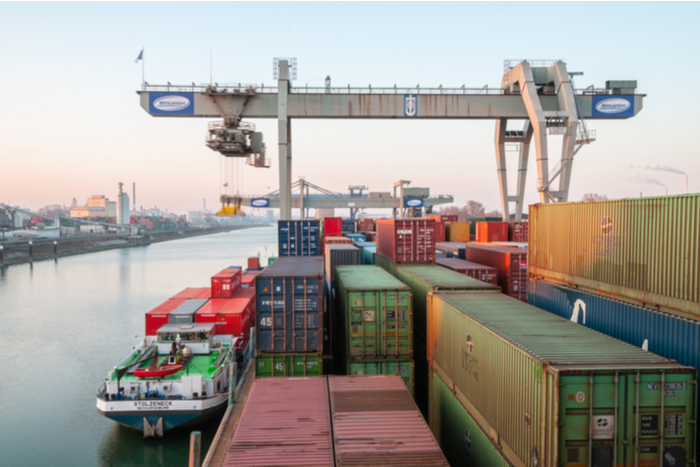
Carriers in Europe say advance bookings do not suggest “right now” that cargo would need to be rolled in Asia in July. Photo credit: Shutterstock.com.
Forwarders are reporting tightening space on the Asia-Europe trade as blank sailings have left little room to accommodate rising import demand from Europe’s reopened economies.
Carriers have so far managed to keep supply approximately in line with demand, evidenced by spot container freight rates that continue to rise despite falling volumes. Forwarders are keeping a watchful eye on bookings and available capacity, but two of the leading non-vessel operating common carriers (NVOs) on Asia-Europe are not expecting widespread rolling of cargo such as occurred on the trans-Pacific.
Dominique von Orelli, head of ocean freight for DHL Global Forwarding, said he did not believe Asia-North Europe would follow the same path as the trans-Pacific, where NVOs reported carriers rolling cargo as they struggled to accommodate an unexpected surge in imports since late May when most non-essential businesses reopened after COVID-19 lockdowns.
Von Orelli noted that Asia-North Europe carriers have deployed extra loaders and sweepers, while shippers have shifted their volume around to different alliances as they adjust to blanked sailings.
“The situation is very tense, but under control,” von Orelli said. “A sudden spike could take carriers by surprise, but we don’t expect this to happen given the forecasts. Increased volume? Yes. A real spike? No.”
Franziska Reckling, global sea logistics marketing manager for Kuehne + Nagel, told JOC.com capacity was tightening on many trades, including Asia–Europe, but the forwarder has not had any issues securing space or with cargo being rolled. Reckling attributed this — at least in part — to accurate volume projections from K + N’s shipper customers.
“Customers who are able to make quality forward-looking volume forecasts for six to eight weeks will, of course, benefit from this routine, and it allows for proper allocation planning and thus improves operational stability,” she said.
European lockdowns began to ease in late May, when retail outlets reopened and factories resumed production, which has led to an increase in demand for goods from Asia at the same time as significant capacity has been taken out of service by carriers.
The extensive amount of blank sailings on Asia-Europe routes has left little room for error should there be any spike in demand, with vessel capacity on the trade well below pre-coronavirus levels, according to maritime analyst Alphaliner. On June 1, weekly deployed capacity in the Asia–Europe trade stood at 361,100 TEU, down 17.1 percent (74,300 TEU) from the same point last year.
However, not all forwarders are positive about the supply-demand balance. Keith Gaskin, group commercial director for SEKO Logistics, said the capacity cuts will lead to an increase in cargo being rolled in Asia through the summer.
“With so much westbound ocean capacity removed from service, July could be ugly,” Gaskin told JOC.com. “With a lot of the importers and retailers returning, demand is currently outstripping supply, and this could continue for some months.”
No sign of rolls, say carriers
The spokesperson for a major carrier based in Europe said its advance bookings did not suggest “right now” that any cargo would need to be rolled in Asia in July. Carriers have pointed out that demand on the Asia-Europe trade has not been as strong as on the trans-Pacific, where SEKO Logistics said carriers are even considering a peak season surcharge.
“The challenge for the carriers is to ascertain whether this current upsurge is likely to continue or is partly down to a purging of the old purchase orders that were halted back in March and could drop off again in the coming months,” Gaskin said. “Any carrier that is close to the market and can be nimble to remove or re-deploy capacity according to market demands could be extremely successful in navigating an extremely turbulent situation.”
Rolf Habben Jansen, CEO of Hapag-Lloyd, told a recent episode of JOC Uncharted that bookings began to recover through the second quarter and he expected volume to improve further in the third quarter and through the last three months of the year and into 2021.
IHS Markit, parent company of JOC.com, is predicting a 10.1 percent year-over-year drop in global container volume in 2020. In a June 15 episode of JOC Uncharted, Neil Glynn, European transport equity research at Credit Suisse, said global volume in the second half of the year would be down 10 percent compared with the same period of 2019, while Nilesh Tiwary, manager at Drewry Maritime Financial Research, is expecting overall volume for 2020 to fall 8 percent year over year.
To match their capacity with the expected demand decline, both 2M and THE Alliance have temporarily suspended their largest Asia-North Europe loops until the end of September, Alphaliner said in its latest newsletter. Capacity deployed by THE Alliance as of June 1 was 22.7 percent lower than at the same time last year, while 2M’s capacity is 18 percent lower, which Alphaliner said was largely due to the suspension of services.
As the Ocean Alliance has not suspended any services, and has only canceled individual sailings to limit capacity, the capacity offering of members Cosco Shipping, CMA CGM, and Evergreen is down 12.4 percent compared with June 1, 2019.
The restriction of capacity has driven up spot rates on Asia-Europe. China-North Europe rates are currently up 18 percent compared with the same week last year at $890 per TEU, with China-Mediterranean spot rates up 34 percent at $968 per TEU, according to the Shanghai Containerized Freight Index. The weekly rate movements are tracked at the JOC Shipping & Logistics Pricing Hub.
Contact Greg Knowler at [email protected] and follow him on Twitter: @greg_knowler.

